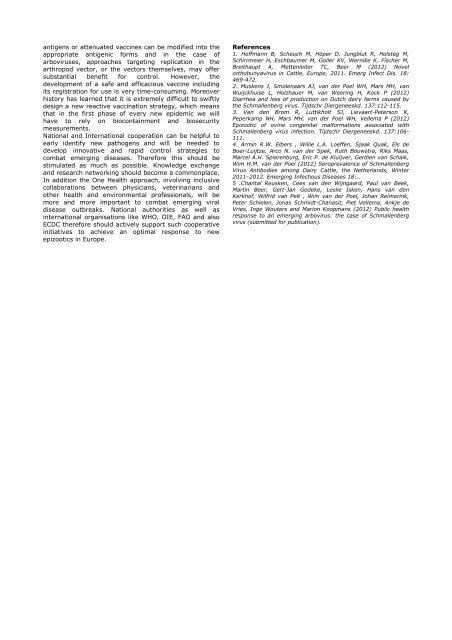Abstract Book of EAVLD2012 - eavld congress 2012
Abstract Book of EAVLD2012 - eavld congress 2012
Abstract Book of EAVLD2012 - eavld congress 2012
You also want an ePaper? Increase the reach of your titles
YUMPU automatically turns print PDFs into web optimized ePapers that Google loves.
antigens or attenuated vaccines can be modified into the<br />
appropriate antigenic forms and in the case <strong>of</strong><br />
arboviruses, approaches targeting replication in the<br />
arthropod vector, or the vectors themselves, may <strong>of</strong>fer<br />
substantial benefit for control. However, the<br />
development <strong>of</strong> a safe and efficacious vaccine including<br />
its registration for use is very time-consuming. Moreover<br />
history has learned that it is extremely difficult to swiftly<br />
design a new reactive vaccination strategy, which means<br />
that in the first phase <strong>of</strong> every new epidemic we will<br />
have to rely on biocontainment and biosecurity<br />
measurements.<br />
National and International cooperation can be helpful to<br />
early identify new pathogens and will be needed to<br />
develop innovative and rapid control strategies to<br />
combat emerging diseases. Therefore this should be<br />
stimulated as much as possible. Knowledge exchange<br />
and research networking should become a commonplace.<br />
In addition the One Health approach, involving inclusive<br />
collaborations between physicians, veterinarians and<br />
other health and environmental pr<strong>of</strong>essionals, will be<br />
more and more important to combat emerging viral<br />
disease outbreaks. National authorities as well as<br />
international organisations like WHO, OIE, FAO and also<br />
ECDC therefore should actively support such cooperative<br />
initiatives to achieve an optimal response to new<br />
epizootics in Europe.<br />
References<br />
1. H<strong>of</strong>fmann B, Scheuch M, Höper D, Jungblut R, Holsteg M,<br />
Schirrmeier H, Eschbaumer M, Goller KV, Wernike K, Fischer M,<br />
Breithaupt A, Mettenleiter TC, Beer M (<strong>2012</strong>) Novel<br />
orthobunyavirus in Cattle, Europe, 2011. Emerg Infect Dis. 18:<br />
469-472.<br />
2. Muskens J, Smolenaars AJ, van der Poel WH, Mars MH, van<br />
Wuijckhuise L, Holzhauer M, van Weering H, Kock P (<strong>2012</strong>)<br />
Diarrhea and loss <strong>of</strong> production on Dutch dairy farms caused by<br />
the Schmallenberg virus. Tijdschr Diergeneeskd. 137:112-115.<br />
3. Van den Brom R, Luttikholt SJ, Lievaart-Peterson K,<br />
Peperkamp NH, Mars MH, van der Poel WH, Vellema P (<strong>2012</strong>)<br />
Epizootic <strong>of</strong> ovine congenital malformations associated with<br />
Schmallenberg virus infection. Tijdschr Diergeneeskd. 137:106-<br />
111.<br />
4. Armin R.W. Elbers , Willie L.A. Loeffen, Sjaak Quak, Els de<br />
Boer-Luijtze, Arco N. van der Spek, Ruth Bouwstra, Riks Maas,<br />
Marcel A.H. Spierenburg, Eric P. de Kluijver, Gerdien van Schaik,<br />
Wim H.M. van der Poel (<strong>2012</strong>) Seroprevalence <strong>of</strong> Schmallenberg<br />
Virus Antibodies among Dairy Cattle, the Netherlands, Winter<br />
2011–<strong>2012</strong>. Emerging Infectious Diseases 18:..<br />
5 .Chantal Reusken, Cees van den Wijngaard, Paul van Beek,<br />
Martin Beer, Gert-Jan Godeke, Leslie Isken, Hans van den<br />
Kerkh<strong>of</strong>, Wilfrid van Pelt , Wim van der Poel, Johan Reimerink,<br />
Peter Schielen, Jonas Schmidt-Chanasit, Piet Vellema, Ankje de<br />
Vries, Inge Wouters and Marion Koopmans (<strong>2012</strong>) Public health<br />
response to an emerging arbovirus: the case <strong>of</strong> Schmallenberg<br />
virus (submitted for publication).


